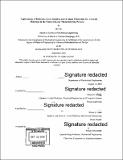Applications of reference cycle building and K-shape clustering for anomaly detection in the semiconductor manufacturing process
Author(s)
He, Han, M. Eng Massachusetts Institute of Technology
DownloadFull printable version (11.01Mb)
Other Contributors
Massachusetts Institute of Technology. Department of Mechanical Engineering.
Advisor
Duane S. Boning.
Terms of use
Metadata
Show full item recordAbstract
Early and accurate anomaly detection plays a key role in reducing costs and improving benefits, especially for complicated and time-consuming manufacturing such as semiconductor production. A case study of detecting anomalies from several monitored parameters during one plasma etching process is presented in this thesis. The thesis focuses on optimized ways to build reference cycles, or centroids of univariate parameters, a critical component to determine clustering accuracy and to facilitate process engineers' offline anomaly detections and diagnoses. Three time series centroid building methods are discussed and evaluated in the thesis, arithmetic, the Dynamic Time Warping Barycenter Averaging (DBA), and the soft-DTW-based centroid. As a result, DBA is chosen considering its comprehensive performance of accuracy and calculation time. Optimizations on DBA is further discussed to reduce calculation time. The window constraint, as well as the recalculation method of combining the previous centroid and new datasets, substantially reduce calculation time with slight accuracy loss. Based upon one centroid building method, shape extraction, a novel clustering method, k-shape, is implemented and applied to the plasma etching process. It is found that it achieves great accuracy with substantially shorter calculation time than one mainstream clustering method, k-means.
Description
Thesis: M. Eng. in Advanced Manufacturing and Design, Massachusetts Institute of Technology, Department of Mechanical Engineering, 2018. Cataloged from PDF version of thesis. Includes bibliographical references (pages 68-69).
Date issued
2018Department
Massachusetts Institute of Technology. Department of Mechanical EngineeringPublisher
Massachusetts Institute of Technology
Keywords
Mechanical Engineering.